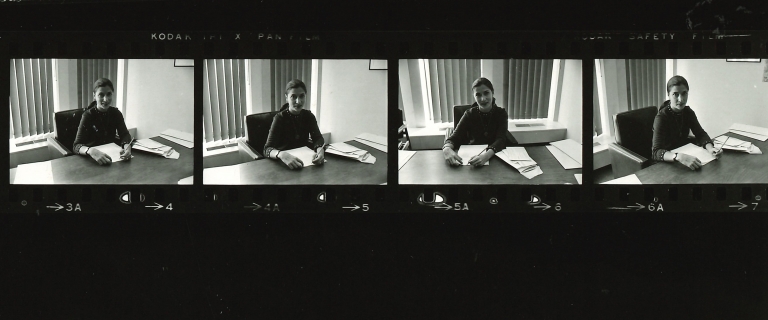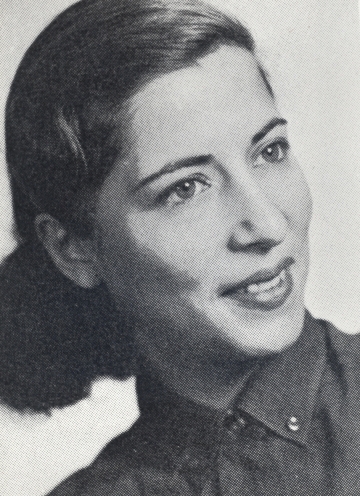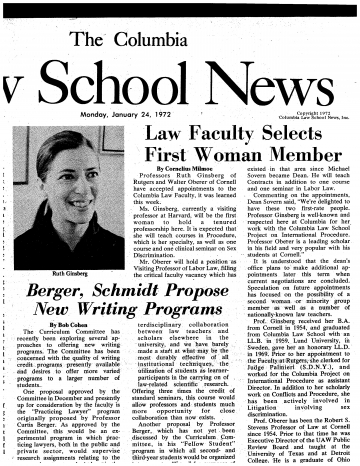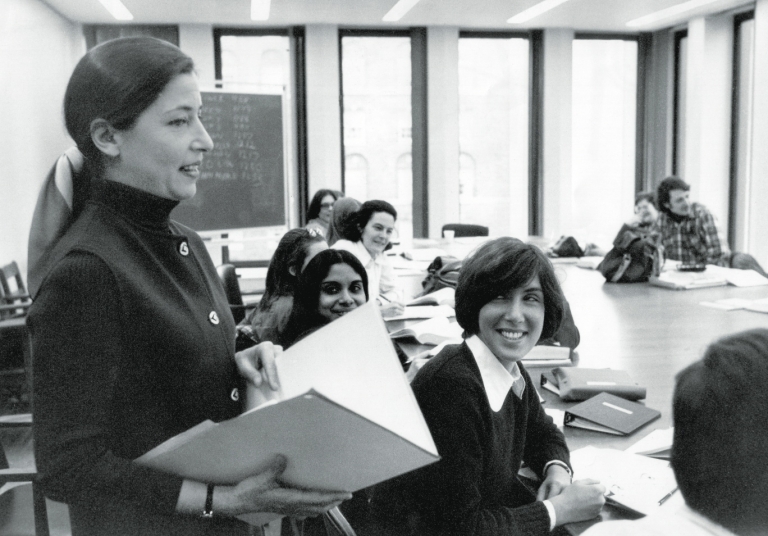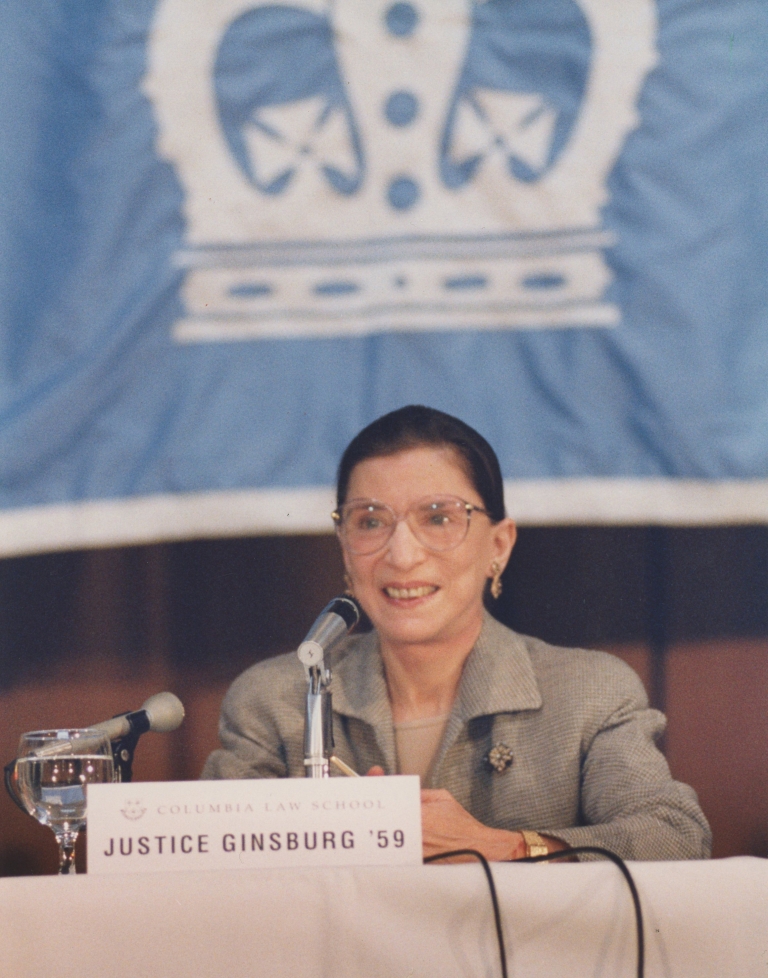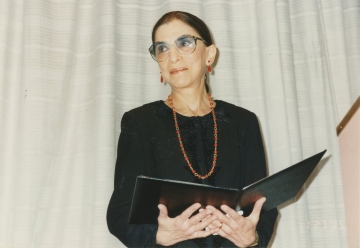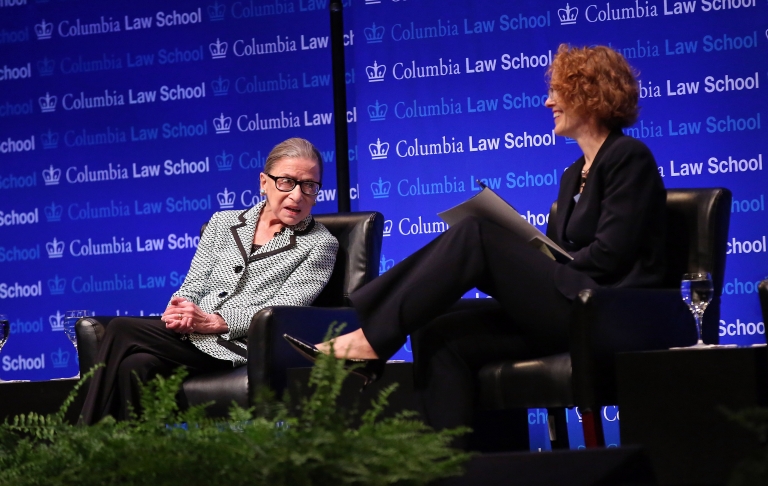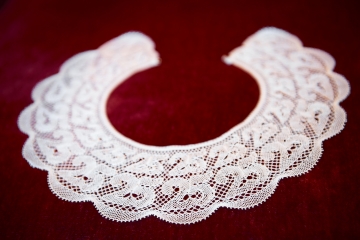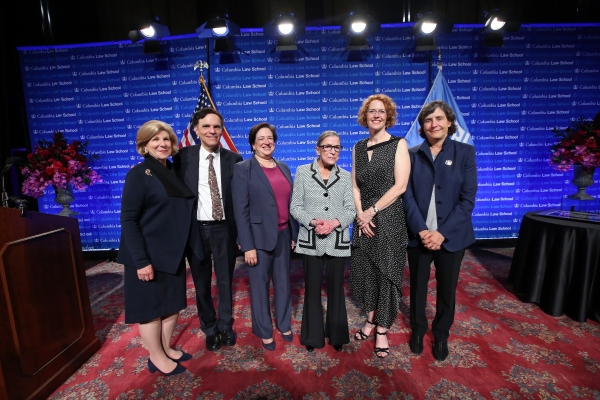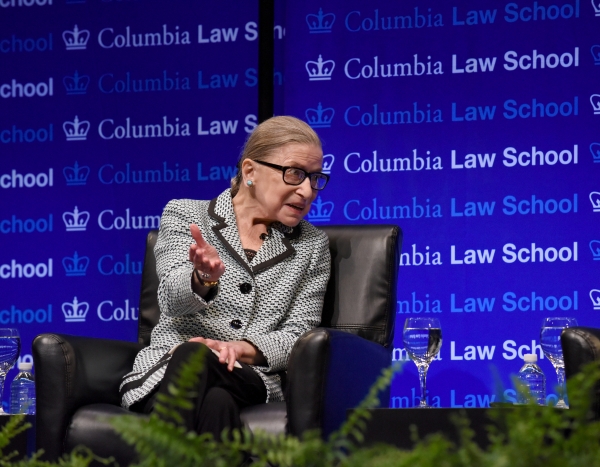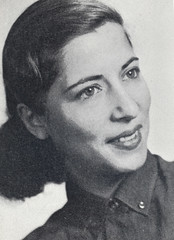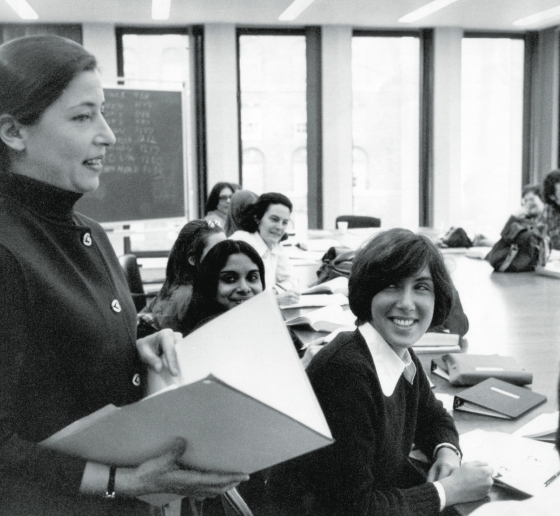In Memoriam: Ruth Bader Ginsburg ʼ59
The revered Supreme Court justice maintained deep ties throughout her life to Columbia Law School, where she graduated tied for first in her class and later became the first woman to be a tenured member of the faculty.
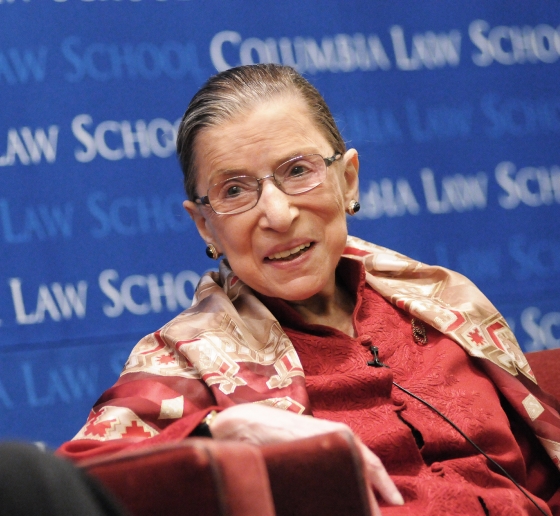
Justice Ruth Bader Ginsburg ’59, the legendary legal visionary with steely resolve and searing intelligence, who was the first female tenured professor at Columbia Law School and the second woman to serve as a justice on the U.S. Supreme Court, died at her home in Washington, D.C., on September 18, 2020, at the age of 87.
Over the course of her career, the soft-spoken, Brooklyn-born lawyer developed a powerful voice as a strategic litigator, teacher, feminist, scholar, judge, and advocate for gender equality in the courtroom and beyond.
“We are heartbroken by the news that Justice Ginsburg has died,” said Gillian Lester, Dean and the Lucy G. Moses Professor of Law. “Since 1958, when she arrived at Columbia Law School for her 3L year, Justice Ginsburg made an indelible impact at every turn—first as a star student, then as a trailblazing and dauntless professor and advocate, and finally as a devoted alumna. In Columbia Law School’s long and venerable history, I am hard pressed to think of an individual who more singularly elevated our collective aspirations.”
When she joined the Columbia Law School faculty, in 1972, Ginsburg co-founded the American Civil Liberties Union’s (ACLU) Women’s Rights Project in order to challenge laws that treated the sexes differently. She masterminded a step-by-step approach to constructing a groundbreaking body of gender-equality jurisprudence, which earned her the reputation as the legal architect of the women’s movement. Her strategy—based on the assumption that male judges might empathize with plaintiffs of their own sex—was to fight not only for the women who were discriminated against but also for the men who had been denied legal benefits designated for women. During the 1970s, while teaching full-time at Columbia, she argued six successful landmark cases before the U.S. Supreme Court and oversaw more than 300 sex discrimination cases on the ACLU’s women’s rights docket.
As a professor, Ginsburg introduced the Law School’s first Sex Discrimination Law course and seminar into the curriculum, training future women’s rights advocates.
As a judge on the U.S. Court of Appeals for the District of Columbia Circuit (1980–1993) and then as a justice on the Supreme Court (1993 to 2020), Ginsburg authored scrupulously reasoned opinions and passionate dissents, which were written with force, clarity, and precision. She famously carried a pocket-sized copy of the Constitution with her at all times.
The Early Years
Joan Ruth Bader was born on March 15, 1933, and raised in the Flatbush neighborhood of Brooklyn, New York. Her father, Nathan, a furrier, emigrated from Russia as a teenager, and her mother, Celia Amster Bader, was the daughter of Polish immigrants. After graduating from James Madison High School, where Ginsburg was a cheerleader and an editor of the student newspaper, she attended Cornell University and met Martin Ginsburg, whom she described as “the only young man I dated who cared that I had a brain.” The couple married in 1954 and lived in Oklahoma while Marty, as he was known, served in the military. In 1955, they moved to Massachusetts, where Marty commenced studies at Harvard Law School; Ruth enrolled the following year.
After Marty graduated in 1958, he joined Weil, Gotshal & Manges LLP in New York City, and Ruth transferred to Columbia for her final year of law school, where she was one of 12 women in the Class of 1959. Despite graduating tied for first in her class, Ginsburg was not offered a job by any of the 12 firms that invited her for interviews. She suspected that none would hire her because she was Jewish, female, and the mother of a young daughter, Jane Ginsburg, who is now the Morton L. Janklow Professor of Literary and Artistic Property Law at Columbia Law School and faculty co-director of the Kernochan Center for Law, Media and the Arts. “Probably motherhood was the major impediment,” she said. “The fear was that I would not be able to devote my full mind and time to a law job.”
But through Columbia Law School’s extensive alumni and faculty network, Ginsburg landed her first two jobs. One of her favorite professors, Gerald Gunther, urged Judge Edmund Palmieri ʼ29 to employ her as a clerk on the U.S. District Court for the Southern District of New York, where she worked from 1959 to 1961. Professor Hans Smit ’58 then hired her as a researcher and associate director of Columbia’s Project on International Procedure. In 1963, Ginsburg, who had developed an academic passion for civil procedure, became a professor at Rutgers Law School, where she received tenure in 1969.
Cracking the Ivory Tower—and the Glass Ceiling
On January 21, 1972, Columbia Law School Dean Michael I. Sovern ’55 announced that Ginsburg had accepted an appointment as a tenured professor of law. At a time when women and people of color were underrepresented on university faculties, the news of Ginsburg’s hiring reverberated beyond the academic and legal communities. “Columbia Law Snares a Prize in the Quest for Women Professors,” read the headline a few days later in The New York Times, which called the appointment a “major coup.”
Ginsburg’s legendary work ethic—she often toiled until 3 or 4 a.m. throughout her career—was evident in the 1970s, as she combined academic commitments with high-profile impact litigation at the Supreme Court. The first case she argued before the court—Frontiero v. Richardson (1973)—was a transformative experience. “I was very nervous,” she recalled in an interview with Elle magazine. “It was an afternoon argument. I didn’t dare eat lunch. There were many butterflies in my stomach. I had a very well-prepared opening sentence I had memorized. Looking at them, I thought, I’m talking to the most important court in the land, and they have to listen to me, and that's my captive audience. [Then] I felt a sense of empowerment because I knew so much more about the case, the issue, than they did.” The court ruled in favor of Ginsburg’s argument that husbands could be considered their wives’ dependents for U.S. military benefits.
In oral arguments, Ginsburg was a captivating storyteller. She taught the all-male court about the deleterious real-world ramifications of discrimination for men and for women. She famously quoted the abolitionist Sarah Grimké: “I ask no favor for my sex. All I ask of our brethren is that they take their feet off our necks.” She convinced the court that the equal protection clause of the 14th Amendment was applicable not only to race but also to gender. For example, in the 1975 case Weinberger v. Wiesenfeld, she persuaded the court that a young widower was entitled to the same Social Security survivor’s benefits that a widow would have received as the surviving spouse to care for their child.
Ginsburg’s legal battles against gender discrimination—a term she used instead of sex discrimination at the suggestion of her Columbia Law secretary, Milicent Tyron, who thought the word “sex” had a suggestive connotation for men—informed her teaching at the Law School. “She was the only member of the faculty who taught the law that she created,” said Smit. “Her classes were so great because she was really telling her life story.”
The Washington Years
Ginsburg was appointed by President Jimmy Carter to the U.S. Court of Appeals for the District of Columbia Circuit in June 1980, and she resigned from the Law School faculty. In her 13 years as an appellate judge, she developed a reputation as a conciliator and a peacemaker on the court. Her husband, a prominent New York tax lawyer who was a tenured professor at Columbia Law School from 1979 to 1980, followed her to Washington; he was a professor at the Georgetown University Law Center and of counsel at Fried, Frank, Harris, Shriver & Jacobson until his death, in 2010.
In June 1993, President Bill Clinton nominated Ginsburg to serve on the U.S. Supreme Court. In a Rose Garden speech announcing her appointment, Clinton praised Ginsburg’s pioneering work on behalf of women. “She has compiled a truly historic record of achievement in the finest traditions of American law and citizenship,” he said. She took her seat on the high court in August 1993.
Ginsburg’s majority opinions and dissents were famously rigorous and robust. Writing for the majority in the landmark 1996 case United States v. Virginia, Ginsburg held that the all-male Virginia Military Institute violated the Constitution by refusing to admit women: “Neither federal nor state government acts compatibly with equal protection when a law or official policy denies to women, simply because they are women, full citizenship stature—equal opportunity to aspire, achieve, participate in and contribute to society based on their individual talents and capacities.”
In a rare move in 2007, Ginsburg read her dissent from the bench in the employment discrimination case Ledbetter v. Goodyear Tire & Rubber Co. The majority had ruled against Lily Ledbetter’s pay discrimination claim, citing her failure to file her complaint within 180 days of the incident as required under Title VII of the Civil Rights Act. Ginsburg argued that the window was too narrow to accommodate the often incremental nature of pay discrimination; she rebuked her colleagues and urged legislative action. “This is not the first time the Court has ordered a cramped interpretation of Title VII, incompatible with the statute’s broad remedial purpose,” she said. “Once again, the ball is in Congress’ court.” Congress listened. Two years later, it passed the Lilly Ledbetter Fair Pay Act of 2009, which expanded the statute of limitations in wage-discrimination cases.
Ginsburg was also renowned for her collegial relationship with her fellow justices, especially her close friendship with her ideological opposite Justice Antonin Scalia. She described the pair as “best buddies” who shared a love of opera and travel.
A Homecoming
Ginsburg maintained a special bond with Columbia Law School beyond her years on the faculty. As a judge, she hired more than two dozen Columbia Law School graduates to serve in her chambers as law clerks, many of whom went on to become leaders in the legal profession. Dean Emeritus and Harvey R. Miller Professor of Law David Schizer, a leading tax law expert, remained close with Ginsburg over the years. “RBG was a diminutive giant. As her law clerk, I was privileged to experience firsthand the power of her intellect and the generosity of her spirit,” he said. “I can think of very few people who single handedly changed the world. Ruth Bader Ginsburg is one of those rare people.”
As an alumna, Ginsburg returned to Morningside Heights over the years for reunions, conferences, speaking engagements, and special events. In 2018, the Law School held a celebration of the 25th anniversary of Ginsburg’s investiture to the Supreme Court, featuring a conversation with Dean Lester before an audience of 1,000 students, faculty, alumni, and friends. “Justice Ginsburg’s work has, for more than half a century, called on us to sit up and take notice of social practices whose familiarity had made us complacent,” said Dean Lester. “She challenges us not only to notice but to speak up and act on the values we claim to espouse. This is the standard Justice Ginsburg has set for each of us.”
During the celebration—which included a panel discussion on impact litigation moderated by Ginsburg’s one-time clerk Gillian Metzger ’96, Harlan Fiske Stone Professor of Constitutional Law at Columbia Law School—Ginsburg spoke of serving on the court until at least 90 like her colleague Justice John Paul Stevens, who retired in 2010 after serving 35 years. “My hope and expectation, if my physical and mental fitness holds up, is to stay in office at least that long,” she said.
The 25th anniversary event garnered international media attention when Ginsburg answered an audience question about capital cases; she said they always caused her “tremendous anxiety,” and she proclaimed: “If I were queen, there would be no death penalty.”
Ginsburg also exhorted students to devote at least part of their careers to public service: “If all you are going to do with your law degree is turn over a buck for a paying client, then you will be very much like a plumber. You have a skill that you can do. But if you are a true professional, you will use your degree to make things a little better for other people.”
According to her colleague Justice Elena Kagan, who paid tribute to Ginsburg at the gala 25th anniversary dinner at Columbia University’s Low Memorial Library, Ginsburg’s legacy also includes coining the phrase “pathmarking.”
“Do you think that’s a word?” said Kagan. “If you’re a Justice Ginsburg clerk, you know it’s a word even though it appears in no dictionary that I have ever been able to find. . . . Every RBG opinion has the word ‘pathmarking’ in it. So I’m going to say that Justice Ginsburg invented this word in order to describe herself.”
The Law School commemorated the anniversary by producing a limited-edition book, Sincerely, Ruth Bader Ginsburg, featuring previously unpublished letters, remarks, photos, and memos to Columbia University presidents, Law School deans, and colleagues—as well as their replies—that illuminated not only Ginsburg’s prodigious intellect and sharp legal mind but also her deep respect and affection for her colleagues, mentors, friends, and family.
A National Treasure
Countless honors and awards were bestowed upon Ginsburg over the years, including the American Bar Association (ABA) Medal, the group’s highest honor; the Thurgood Marshall Award from the ABA’s Section of Civil Rights and Social Justice; the LBJ Liberty & Justice for All Award; the $1 million Genesis Prize that celebrates Jewish talent and achievement; the $1 million Berggruen Prize for Philosophy & Culture; and honorary degrees from more than two dozen colleges, universities, and law schools.
In the final decade of her life, Ginsburg became an unlikely pop culture icon. She was nicknamed Notorious R.B.G. (a nod to the late Brooklyn-born rapper Notorious B.I.G.) on a Tumblr page in 2013, which led to the publication of the 2015 best-seller Notorious RBG. Her likeness was emblazoned on T-shirts and tote bags, and she was the subject of two films in 2018: the Academy Award-nominated documentary RBG and the feature On the Basis of Sex, in which she was portrayed by Felicity Jones.
Over the course of her career, Ginsburg never let illness slow her down: She overcame colon, lung, and pancreatic cancer while serving on the court. She didn’t miss a day of oral arguments until 2019.
In May, the Supreme Court began conducting arguments via conference call in response the coronavirus pandemic. Ginsburg participated even when she was hospitalized. In one of her final cases, Ginsburg defended the rights of women to obtain contraceptive coverage regardless of their employer. “In accommodating claims of religious freedom, this court has taken a balanced approach, one that does not allow the religious beliefs of some to overwhelm the rights and interests of others who do not share those beliefs,” Ginsburg wrote in a dissenting opinion in Little Sisters of the Poor v. Pennsylvania, a 7-2 decision allowing employers to opt out from contraceptive health coverage on religious grounds. “Today, for the first time, the court casts totally aside countervailing rights and interests in its zeal to secure religious rights to the nth degree.”
On the day before her death, Constitution Day, Ginsburg was awarded the 2020 Liberty Medal by the National Constitution Center for her “efforts to advance liberty and equality for all.”
In addition to her daughter, Jane, Ginsburg is survived by her son, James, a classical music producer who lives in Chicago; four grandchildren; two stepgrandchildren; and one great-grandchild.
View a photo gallery of Ginsburg at Columbia Law:
